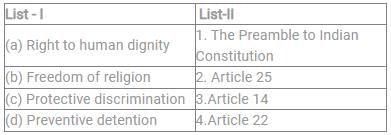Test: CLAT PG Practice Test - 4 - CLAT PG MCQ
30 Questions MCQ Test - Test: CLAT PG Practice Test - 4
Match List I with List II and indicate the correct answer using the codes given below:
Choose the answer corresponding to the order (a) (b) (c) (d)

Choose the answer corresponding to the order (a) (b) (c) (d)

India has not ratified following ILO Convention(s)
In which of the following cases, the Supreme Court discussed the development of the precautionary principle?
Which of the following pair/pairs is/are not correctly matched ? Give correct answer by using the codes given below:
i. Composition of the Security Council of U.N. - Article 23 of the U.N. Charter
ii. Composition of the Economic and Social Council - Article 61 of the U.N. Charter
iii. Composition of the General Assembly of the United Nations - Article 86 of the U.N. Charter
iv. Composition of Trusteeship Council - Article 28 of the U.N. Charter
Which of the following is sensitive personal information according to rule 3 of the Information Technology (Reasonable Security Practices and Procedures and Sensitive Data or Information) Rules, 2011?
- Credit card details
- Medical records
- Mobile number
- Sexual orientation
Which section of the IT Act, 2000 speaks about the recovery of penalty and compensation
The concept of curative petition was applied by the Supreme Court in the case of:
Which theory of punishment implies "An eye for an eye, a tooth for a tooth" approach?
Which of the following statements is correct as per the Constitution of India?
A has murdered her husband. She goes to the police station with the murder weapon and confesses before the police. In view of the principle below, what would be the most correct action for the police? Principle If any person wishes to give his statement or confession in the course of any investigation, such person may do so before a Metropolitan Magistrate or a Judicial Magistrate under section 164 of the Code of Criminal Procedure, 1973.
Which of the following is an example of intangible property?
The dispute settlement body established by UN Convention on Law of the Sea, 1982 is known as ;
Section 82 of the IPC provides that nothing is an offence which is done by a child under
Which of the following is not a leading case on immunity of trade unions from criminal proceedings ?
Which of the following statement(s) is/are correct in relation to 'muta' marriage ?
(a) It is a temporary marriage.
(b) It is recognised under Sunni law.
(c) It is recognised under Shia law.
(d) It is a marriage for a fixed period.
Choose the correct answer: After the House is dissolved, the Speaker is
Which of the following provisions is based on the rule of volenti non fit injuria
Match List I containing events and List II containing corresponding provisions of Indian Partnership Act and select the correct answer using the codes given below:

Hagerstorm rejected the notion of law as command and insisted on morals or as he puts it
In tort, there are two broad categories of activities for which a plaintiff may be held strictly liable
Read Assertion I and Reason II and with the help of codes given below point out the correct explanation.
I. Assertion Generally a master is not criminally liable merely because his servant has committed a negligent act.
II. Reason In ordinary course of employment a master may be criminally liable against the negligent acts of the servant.
Judgement should be delivered to the parties or to their pleaders in the open court
Which one of the following is not a principal Organ of UNO?
Which one of the following doctrines relates to the interpretation of the legislative conflicts between the Union and the States?
















